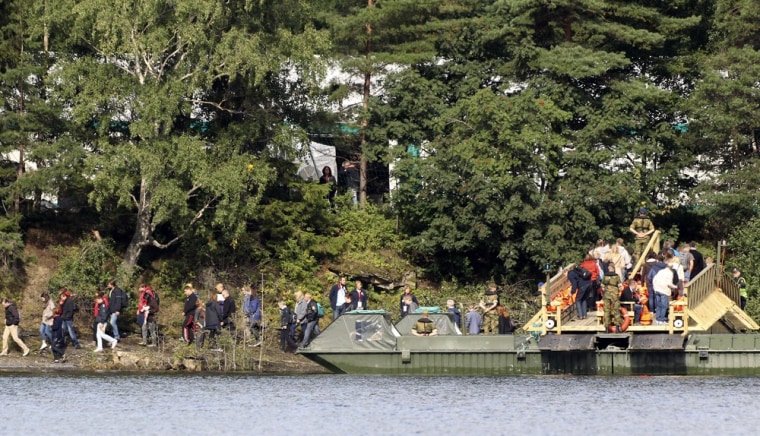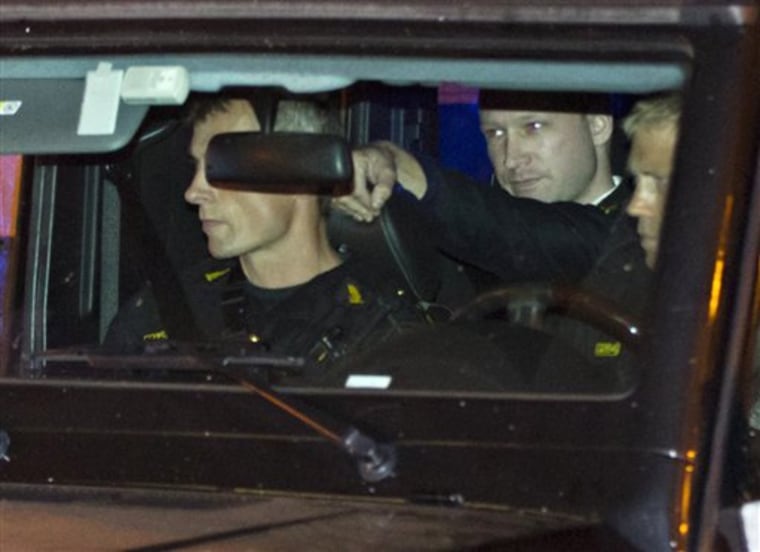Survivors of a massacre which claimed the lives of 69 people in Norway last month carried flowers to the site of the killings Saturday, laughter blending with tears as they remembered the joys of an island youth camp that turned into a scene of horror.
Norway's criminal police chief said Utoya island was "filled with flowers, candles, pictures, poems," after returning from Utoya which he visited with survivors.
Jon Staale Stamnes told reporters that the survivors had "very different" reactions. "Some had — of course — traumatic experiences and it's clear to us that it's a really tough time for them," he said. "But also there's laughter, there's good stories, so there's a total mix and blend of emotions today."
Many lit candles and laid handwritten notes in memory of their friends at the sites where they were shot during the summer camp organized by the youth wing of Norway's Labor Party.
Eskil Pedersen, the leader of the party's youth organization, said his visit to the island with Norwegian Prime Minister Jens Stoltenberg and several hundred youth politicians had been "heavy, but fine."
"It was incredibly good to see them (the survivors) smiling again on Utoya," Pedersen told reporters.
Up to 1,000 survivors and relatives were expected on Utoya, accompanied by police and medical staff, to face the painful memories of the shooting spree by a right-wing extremist.
Stoltenberg — the leader of the Norwegian Labor Party — said he had wanted to visit Utoya "to take part in their mourning and be there for them."

Anders Behring Breivik has admitted killing 77 people on July 22 when he first detonated a truck bomb outside government offices in the capital, Oslo, and then went on a meticulously planned shooting spree on the island, some 25 miles (40 kilometers) away.
Breivik denies criminal guilt because he believes the massacre was necessary to save Norway and Europe. He said the attacks were an attempt at cultural revolution, aimed at purging Europe of Muslims and punishing politicians that have embraced multiculturalism.
On Friday, the Oslo District Court extended Breivik's isolation detention by another four weeks saying it still does not know if he acted alone.
Police said they wanted to keep Breivik in isolation because they didn't want him to talk to other inmates, although they still believe he planned and committed the attacks on his own.
Breivik's case is not expected in court until next year. If found guilty on terrorism charges, he could be sentenced to 21 years in prison. An alternative custody arrangement — if he is still considered a danger to the public — could keep him behind bars indefinitely.

Media were not allowed access to the heavily guarded island where Breivik spent 90 minutes executing the 69 people. Many of the victims were shot in the water as they tried to escape by swimming.
From a distance ferries and a pontoon could be seen shuttling survivors, in bright orange life vests, to the forested island used by the ruling Labor Party for political functions, camping and celebrations.
The prime minister said he "felt such sorrow and emptiness" when he heard news of the July 22 attacks, and could not believe it was true.
Stoltenberg told the VG newspaper in an online interview that when a police officer sent him an SMS message saying one of his friends had been killed he answered him with one word: "Horrific."
"It's like being punched because that's when the violence, the shooting on Utoya gets a face," he said.
Norway's General Director of Health Bjoern Inge Larsen said he hoped the visits would help survivors and families of the victims come to grips with the deaths.
"The people going there today ... have a lot of anxiety," Larsen said. "They were life-threatened on this island four weeks ago in a very traumatizing manner, so what we are prepared for is to help them to overcome that anxiety."
Per Brekke, logistics chief of the operation, that included 400 health care workers, police and other officials, said planning the visits had been a big challenge.
"But, of course, the challenge for each individual to re-enter the island is much bigger," he said.
Some 500 friends and family of the victims killed in the shooting spree visited Utoya on Friday.
On Sunday, a national memorial service is to be held at Oslo Spektrum arena, marking the end of a month of mourning in the Scandinavian country.